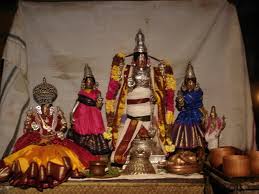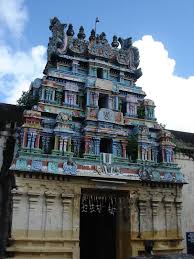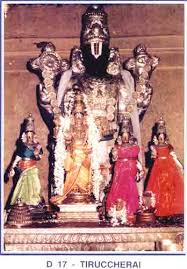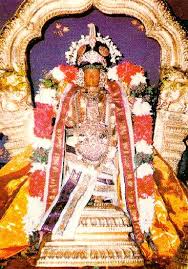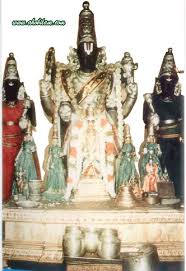
The Lord here is Sri Thalaichanga Nanmadiya Perumal [ஸ்ரீ தலைச் சங்க நாண்மதியம் பெருமாள்]. It is about 15 miles from Seerkazhi and Mayiladuthurai, and about 6 miles from Poompuhar. The Lord is also called Sri Vensudar Perumal [ஸ்ரீ வண் சுடர் பெருமாள்]. Divya desam is called Thalachanga Nanmadiyam [தலைச் சங்க நாண் மதியம்]. Just like the daily appearing Moon reduces heat of the environment, the Lord reduces the hest arising out of samsaram. Sri Thayar is Sri Senkamalavalli Thayar. Vimanam is Chandra vimanam and pushkarini is Chandra pushkarini.
26. THIRU INDALUR திரு இந்தளூர் :


The Lord is Sri Parimala Ranganatha Perumal. This Kshetram is known as Suganda vanam. The Lord is gracing in reclining pose, with Four arms and with discus and conch. This is a rare pose. Pushkarini is Indu pushkarini. Indu, that is Chandra, got rid of his curse by bathing in this and worshiping the Lord here. In the mantap here, one can notice the skillful sculptures. Tirumangai Alwar has praised the Lord in Ten pasurams. Alwar, accuses the Lord, with affectionate right, for not according him darshan immediately on his visit! When the Alwar came, the doors were closed. Alwar could not bear denial of darshan. He requested the Lord to show Himself instantly; but the Lord did not! The Alwar then burst out and beautiful verses followed! He accused the Lord for treating him same like others!
27. KAZHI SRIRAMA VINNAGARAM (SIRKAZHI) காழிச் சீராம விண்ணகரம் [சீர்காழி] :




The forest in this place is called Pasavika vanam. The Lord appeared as Sri Trivikrama for sage Romasa. The Lord is called Sri Thadalan [ஸ்ரீ தாடாளன்]. Since He measured with His feet [Thaal தாள்], He is Sri Thadalan. Did not He measure all the Seven Lokas in Two strides? Sri Thayar is Sri Lokanayaki Thayar. Tirumangai Alwar has composesd 10 pasurams on this Kshetram. The Lord is gracing with the left leg raised up, and with left fore finger stretched, asking Emperor Mahabali for the place to have His next step! Here, there was a competition between Tirugyana Sambandar and Tirumangai Alwar, in composing verses. At that time Alwar speaks out all his titles in the last pasuram: Alinadan, Arattamukki, Adayarseeyam, king of Mangai, Kotravelan, Parakalan, Kaliyan, etc.! Once, when there was an impending danger, an old woman kept the Lord in safe custody, in a husk pot [thavittu paanai தவிட்டுப் பானை]. Therefore, the Lord here is also known as Sri Thavittup paanai Thadalan [ஸ்ரீ தவிட்டுப் பானை தாடாளன்].
28. TIRUK KAVALAMBADI திருக் காவளம்பாடி :

We are going to see the 14 Divya desams of Tirunangur. First being Tirukkavalambadi. The Lord here is Sri Raja Gopala. Kavalam means garden. Kavalampadi means place with gardens. This is about one and half a mile from Tirunangur. The Lord Sri Rajagopala is gracing, on arrival from Dwaraka along with Sri Rukmimi and Sri Satyabama. Tirumangai Alwar while praising this Lord prays to remove all his distress.
29. ARIMEYA VINNAGARAM அரிமேய விண்ணகரம் :



As mentioned earlier, there are Five Vinnagarams - Tiruvinnagar, Kazhi Sri Rama Vinnagar, Nandipurs Vinnagar, Parameswara Vinnagar and Arimeya Vinnagar. The Lord here is Sri Kudamadum Koothar [ஸ்ரீ குடமாடும் கூத்தர்]. The Lord is gracing in seated pose. Sri Thayar is Sri Amrutha Gatavalli Nacchiyar [ஸ்ரீ அம்ருத கடவல்லி நாச்சியார்]. The Lord appeared before sage Udanga. He graces with Four arms, lifting Govardana giri and rescuing people and cattle. Kudamadu Kootthar means the Lord does juggernaut with many pots in His hands! The Lord excels everyone in Rasakreeta, Jalakreeta, Kuravai Kootthu and Kudak Kootthu! Arimeya means always present Hari, vinnagar, that is, Vaikuntam like place.
30. TIRU VAN PURUSHOTTAMAM திரு வண் புருஷோத்தமம் :

Among people, the lowest are Adamas, middle ones are Madyamas and the best are Uttamas. Did not Sri Krishna, in Bhagavd Gita, in Chapter 13, proclaim that He was the Purushottama? We worship that Sri Purushottama only here! Van [வண்] means full of strength. Sri Thayar is Sri Purushottama Nayaki, graces equally here. The Lord appeared to sage Vyagrapada, whose son was Upamanyu. The sage left the child and went out for some work. The child was hungry and started crying, when Sri Thayar supplied milk and pacified the child.
Now we will see sloka 54 of Chapter 18:
brahmabhūtaḥ prasannātmā na śocati na kāṅkṣati
samaḥ sarveṣu bhūteṣu madbhaktiṃ labhate parām 18.54
Sri Krishna tells that then Bhakti emerged. In slokas 50, 51, 52 and 53, we saw the methods to have atman darshan. When atman darshan is reached, thereafter Bhakti has to originate. A person, who understands the atman's real nature alone would get Bhakti. Bhakti's initial stage is called Parabhakti. Brahmabhuta = person, who has attained atman darshan, prasannatma = with clear mind. Mind is uncontaminated. The contamination is caused by klesa [Five worries - avidya - lack of knowledge, asmita - assuming body as atman and so ego, raga - likes, dwesha - dislikes and abinivesa - fear of getting undesirables and fear of losing the desired], karma [accumulated papa/punya], vipakam [result of papa/punya, like birth, oldage, etc] and kama, according to yoga sutra. Na socati = does not suffer, na kanksati = neither delights or expects any. Other than the Lord, this person is not worried about others nor is delighted by others. Sarvesu bhutesu = towards every other living being, sama = [he is] equal. It means not only he sees all as good and does good to all, but he is isolated from all others. He thinks always about the Lord and considering all others as His belongings, renders help to the society. If we think of directly helping others, then we must be prepared for all consequences and disappointments. In fact by considering others as His belongings and helping, will be better and more fruitful. Param labhate = acquires the supreme [gift of], madbhaktim = devotion to Me [Sri Krishna]. Bhakti in Him, is got after atman darshan, which itself is a superior stage. Understanding that atman is different from the world and our body, and knowing its nature of eternality, full of bliss only, servant to the Lord, embodiment of Gyana, etc., is a very sublime stage. If such a person could start devoting himself in the Lord, what to speak of the greatness of the Lord? How much more superior, He is, to atman? This brings him from a self stage, to serving the Lord. Does He have so much greatness? Swami Ramanuja says that the Lord is the Leader of all. He is the Creator, Sustainer and Destroyer. He is blemishless. He is the repository of most wonderful and infinite auspicious qualities. He is embodiment of beauty and excellence. He is always with Sri Thayar, Sri Ranganayaki, who is ever ready to recommend us for pardon, in spite of our infinite crimes. He has lotus like eyes, with which if He glanced at us, all our papa would vanish. He is the Owner of all. Therefore, we have to perform Bhakti, only to Him! Parabhakti matures to Paragyana, which matures to Parama Bhakti. Finally, that person attains Vaikuntam.












